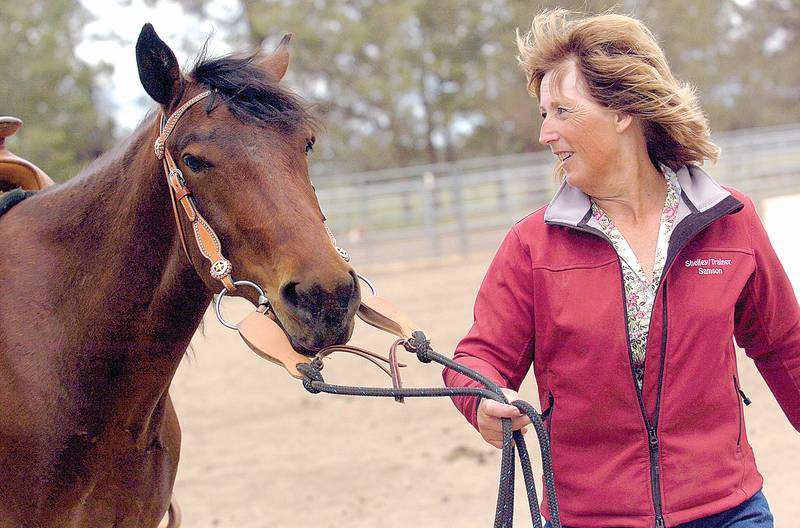One hundred days to make the grade
Published 5:00 am Friday, May 23, 2008

- Shelley Simmons walks her horse, Samson, after training him Tuesday afternoon at Cline Falls Ranch in Redmond.Anthony Dimaano The Bulletin
REDMOND — It’s a blustery morning at Cline Falls Ranch. Young schoolchildren scamper about the grounds as they tour the 200-acre equestrian facility, mini horses prance in a nearby corral, and a tiger-striped barn kitty gets a sniff from the muzzle of one of the ranch’s newer residents.
Samson stands quietly tied to a horse trailer — apparently without regard for the whirlwind of activity, save for an occasional cat nudge — while his handler, Shelley Simmons of Redmond, brushes his mane and tail, and preps him for a daily workout.
A well-mannered horse, one that respects space and stands quietly without pawing or pulling, isn’t all that remarkable — even for a youngster like 4-year-old Samson.
But consider this: Just 80 days earlier Samson was a wild, undomesticated horse who other than to be vaccinated and gelded had never been touched by human hands.
“These are the horses that people passed on time and again,” says Simmons. “He was in a holding pen but not touched and still wild.”
Simmons and Samson were matched back in early March after Simmons was one of 30 applicants from Oregon, California, Washington, Nevada and Arizona selected to compete in the inaugural Western States Mustang Challenge.
The chosen trainers — some professional and some, like Simmons, who are amateurs — have 100 days to show what they can do with a once-wild mustang. The horse-and-rider teams are slated to compete June 6-8 for a piece of a $7,500 purse at the Mustang Challenge, which will be part of the 10th annual Western States Horse Expo in Sacramento, Calif.
Simmons, 46, has been riding horses most her life. Following high school she graduated from a two-year horsemanship school, and although she never embarked on a professional career, she continued to raise and train her own mounts for pleasure.
In the last five years, Simmons — a school-bus driver for the Redmond School District and the mother of three children ranging in age from 12 to 21 — has become particularly interested in mounted trail competitions. But for all her years of experience, she had never worked with a wild mustang.
“I tell people this is my midlife crisis,” laughs Simmons, who then adds more seriously that what compelled her to apply for an invitation to the Western States Mustang Challenge was “the challenge of taking a horse that knows nothing — knows nothing at all — and turning him into a riding horse.”
Naturally, Simmons was fearful on March 9 when she first entered Samson’s round pen intent on beginning the process: first halter breaking and in-hand training, then ground driving, and finally on horseback — all of which slowly took place over weeks and months without incident.
Simmons, who spends a minimum of two hours each day working with Samson, says consistency and patience are key to seeing results. In one of several outdoor pens at Cline Falls Ranch, Samson responds dutifully as Simmons asks him to perform haunch turns and to back up in the shape of an L.
“I’m amazed that it came so fast,” she says of Samson’s progress. “They’re so workable.”
It doesn’t hurt that Samson’s favorite pastime, according to his handler, is sleeping.
“He’s very laid-back, almost too much,” says Simmons. “My challenge now is to get him motivated.”
Samson was plucked from the Twin Peaks Herd Management area, located on 800,000 acres northeast of Susanville along California’s northeastern border with Nevada. According to the Bureau of Land Management, some of the original wild horses in that area descended from Spanish stock. Today, most of the herd is made up of descendants of early 20th-century U.S. Cavalry remounts, and of draft and light breeds from historic ranch stock.
A bay gelding with a jet-black mane and tail and a clay-red coat, Samson stands about 14.3 hands tall. His sturdy feet, characteristic of his breed, likely won’t need shoes, and Simmons expects the young horse to excel in trail riding.
According to the Mustang Heritage Foundation, which organizes the competition, the Western States Mustang Challenge is a spinoff of the popular Extreme Mustang Makeover. A field of 100 horses and trainers from across the country competed in the Extreme Mustang Makeover last fall in Texas (where Prineville trainer Kitty Lauman and her mustang, named Ranger, claimed runner-up honors), and a second installment of the mustang makeover program is slated for Sept. 18-21 in Fort Worth, Texas.
Last year’s Makeover debut was so successful that the foundation — in partnership with the BLM — has since coordinated Mustang Challenges in Wyoming and elsewhere in the West and Midwest.
The Western States Challenge follows a format similar to that of the Extreme Makeover contest.
After applicants are selected, they have 100 days to gentle a wild young mustang. During competition, horse-and-rider teams are evaluated in three areas: Judges rate the mustang’s body condition, looking for well-muscled horses with a healthy weight and a shiny coat.
Participants then demonstrate their ability to handle the horse from the ground in a series of maneuvers that include picking up the mustang’s feet, leading and backing through obstacles, and loading into a trailer.
Finally, the riders mount up and complete an obstacle course, which simulates trail and recreational riding situations.
The top 10 point-earning pairs then return to the arena for a final go-round. There, the pairs perform a four-minute freestyle routine that incorporates compulsory moves, such as picking up both the right and left leads, stopping, and performing a 360-degree spin. But the routine can be choreographed however the rider chooses.
After the winner has been announced and the class placed, the performance arena transforms into a public adoption. All the mustangs that were trained and shown for the Challenge go up for bid.
At last year’s Extreme Mustang Makeover in Texas, the winning horse went for $50,000 and the sale average was more than $3,000.
If the price is right, Simmons says, she plans to buy Samson herself rather than see the horse sold to a low bidder. Simmons has volunteered to provide additional training for Samson should a Central Oregon adopter purchase the horse.
“This is a basic foundation,” Simmons insists. “Three months is not a lot of time, especially when they (mustangs) start with nothing.”
Simmons herself has been given help along the way. For a rider who doesn’t own a facility or the safety equipment needed to house a mustang, participating in the Challenge could present an overwhelming financial burden.
Fortunately for Simmons, Cline Falls Ranch offered to stable Samson at no charge, while 3A Livestock Supply in Madras provided the required 6-foot-high round-pen fencing.
Simmons is eager to get to Sacramento and see how other trainers have progressed with their horses. She is confident, though, that Samson will be among the top 10 mounts.
“I’m not so much worried about my skills, but to do it in front of thousands of people?” says Simmons, her voice trailing off. “But I’ve just got to follow through. I’ve come this far.”








